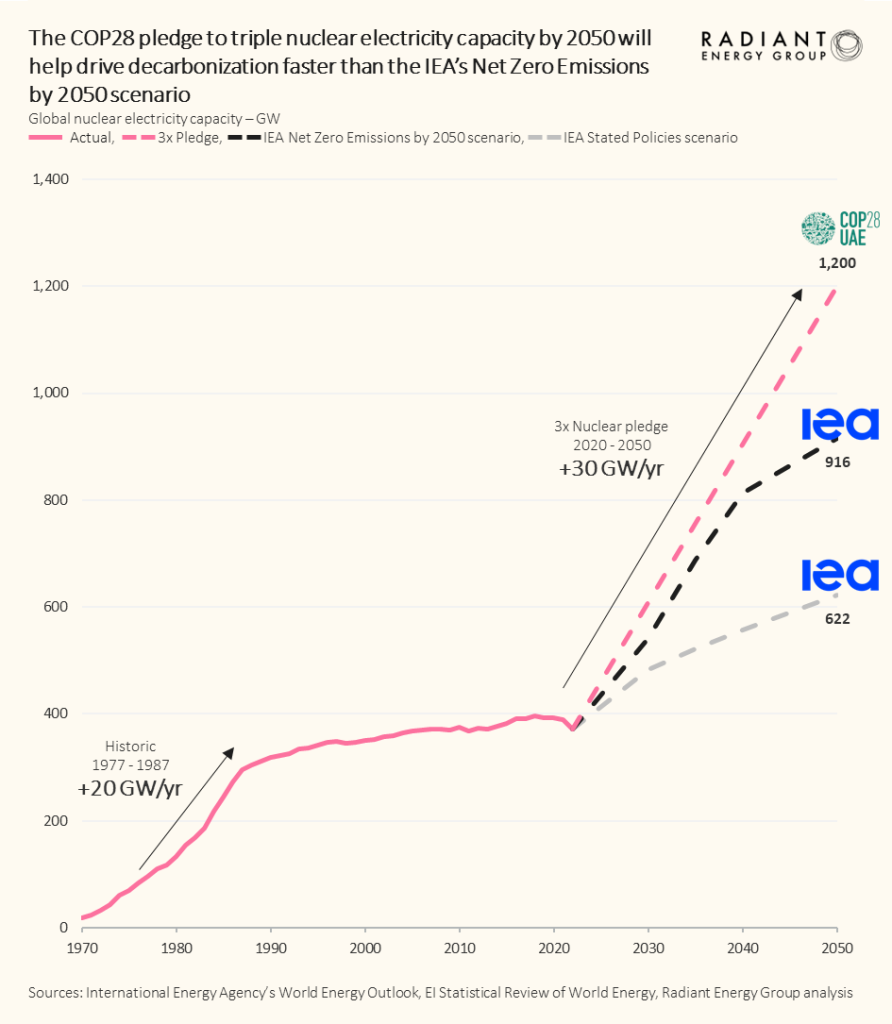Goal #
To reach Net Zero Emissions by 2050 the world needs to add over 200 kWh/capita of clean electricity annually. Nuclear has proven itself as core to the rapid and sustained addition of clean electricity.
The IPCC 1.5°C report published in 2018 presented mitigation scenarios in which to limit the global warming to 1.5ºC the IPCC call for a doubling or more of nuclear generation by 2050 [1]. The International Energy Agency’s (IEA) World Energy Outlook’s (WEO) released on 27th of October 2022 forecasts the global nuclear capacity ned to growth to 916 GW (low) and 1,200 GW (High) by 2050 [2].
At COP28 in december 2023, 22 countries as US, Great Britain, France, Sweden etc, have pledged to triple nuclear capacity by 2050. That implies a global increase of about 800 GW of installed capacity, or about 30 GW per year to 2050 [3].

Can it be done? #
The past decade, the world has only added around 6 GW per year of new capacity. Adding 30GW pa of new nuclear capacity per year would be a massive escalation. But it is doable, because that rate of deployment has been done before [4].
Between 1977 and 1987, the world installed 20 GW nuclear capacity per year following the major energy crises in 1973-74 and 1979-80 [5].
This time it’ll be a global effort. In the 80s only 30 countries built nuclear. Now over 80 countries are considering nuclear builds. China and India alone aim to add 180 GW by 2040. Poland aims to build a total nuclear capacity of 9 GW with large reactors. And also plans 24 SMR units.

How to do #
To succeed, nations must rethink how to build, regulate, and finance nuclear technology and work together to develop a long-term plan for new nuclear plant construction to achieve economies of scale.
A new system will need to deliver standardized products rather than costly and risky one-off First of a kind (FOAK) multi-decade projects. This could mean relying on proven designs of gigawatt-scale reactors. The reasent FOAK projects in US and Europe is showing the immense value of learning from experience. New projects could take advantage of those lessons learned and benefits from anexperienced workforce If they continue to build on the same reactor design multiple times.
The current process for certifying nuclear reactor designs is based on an inefficient country-by-country approach. Developing an international body charged with issuing a single globally accepted generic certification for reactor designs would lower the barriers to nuclear deployment.
Nuclear can look to the aviation industry’s model, which certifies aircraft, subject to strict and uniform standards, across countries [6].
Sources #
- Chapter 2 — Global Warming of 1.5 ºC (ipcc.ch)
- Progress Tracking the IEA’s Latest World Energy Outlook (radiantenergygroup.com)
- Global Market Outlook, + 402 GW of new solar capacity in 2023 (sustainabilityenvironment.com)
- Insights from the World’s Fastest Build-outs of Clean Electricity (radiantenergygroup.com)
- Breakdown of global nuclear capacity – Thunder Said Energy
- cordelaviationreport.pdf (world-nuclear.org)




